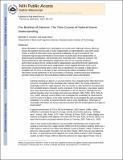The Briefest of Glances: The Time Course of Natural Scene Understanding
Author(s)
Greene, Michelle R.; Oliva, Aude
DownloadOliva-2009-The Briefest of Glances.pdf (474.1Kb)
OPEN_ACCESS_POLICY
Open Access Policy
Creative Commons Attribution-Noncommercial-Share Alike
Terms of use
Metadata
Show full item recordAbstract
What information is available from a brief glance at a novel scene? Although previous efforts to answer this question have focused on scene categorization or object detection, real-world scenes contain a wealth of information whose perceptual availability has yet to be explored. We compared image exposure thresholds in several tasks involving basic-level categorization or global-property classification. All thresholds were remarkably short: Observers achieved 75%-correct performance with presentations ranging from 19 to 67 ms, reaching maximum performance at about 100 ms. Global-property categorization was performed with significantly less presentation time than basic-level categorization, which suggests that there exists a time during early visual processing when a scene may be classified as, for example, a large space or navigable, but not yet as a mountain or lake. Comparing the relative availability of visual information reveals bottlenecks in the accumulation of meaning. Understanding these bottlenecks provides critical insight into the computations underlying rapid visual understanding.
Date issued
2009-04Department
Massachusetts Institute of Technology. Department of Brain and Cognitive SciencesJournal
Association for Psychological Science
Publisher
Psychological Science
Citation
Greene, Michelle R., and Aude Oliva. “The Briefest of Glances: The Time Course of Natural Scene Understanding.” Psychological Science 20.4 (2009): 464–472. Web.
Version: Author's final manuscript
ISSN
0956-7976
1467-9280